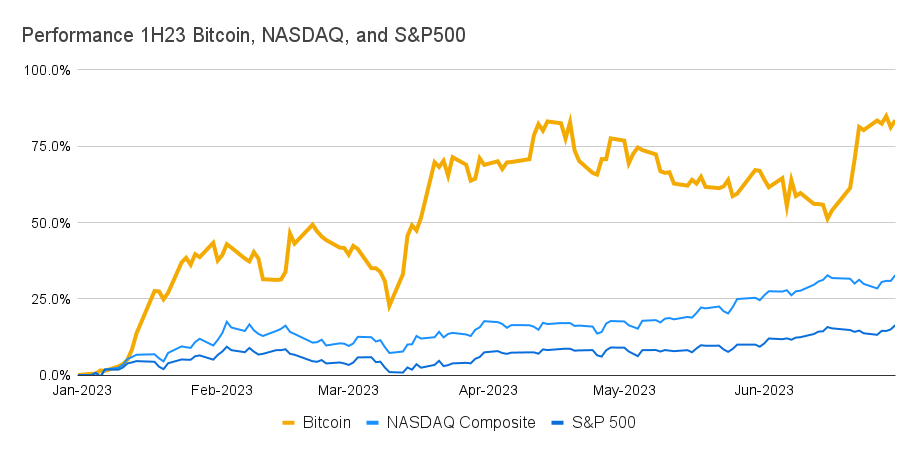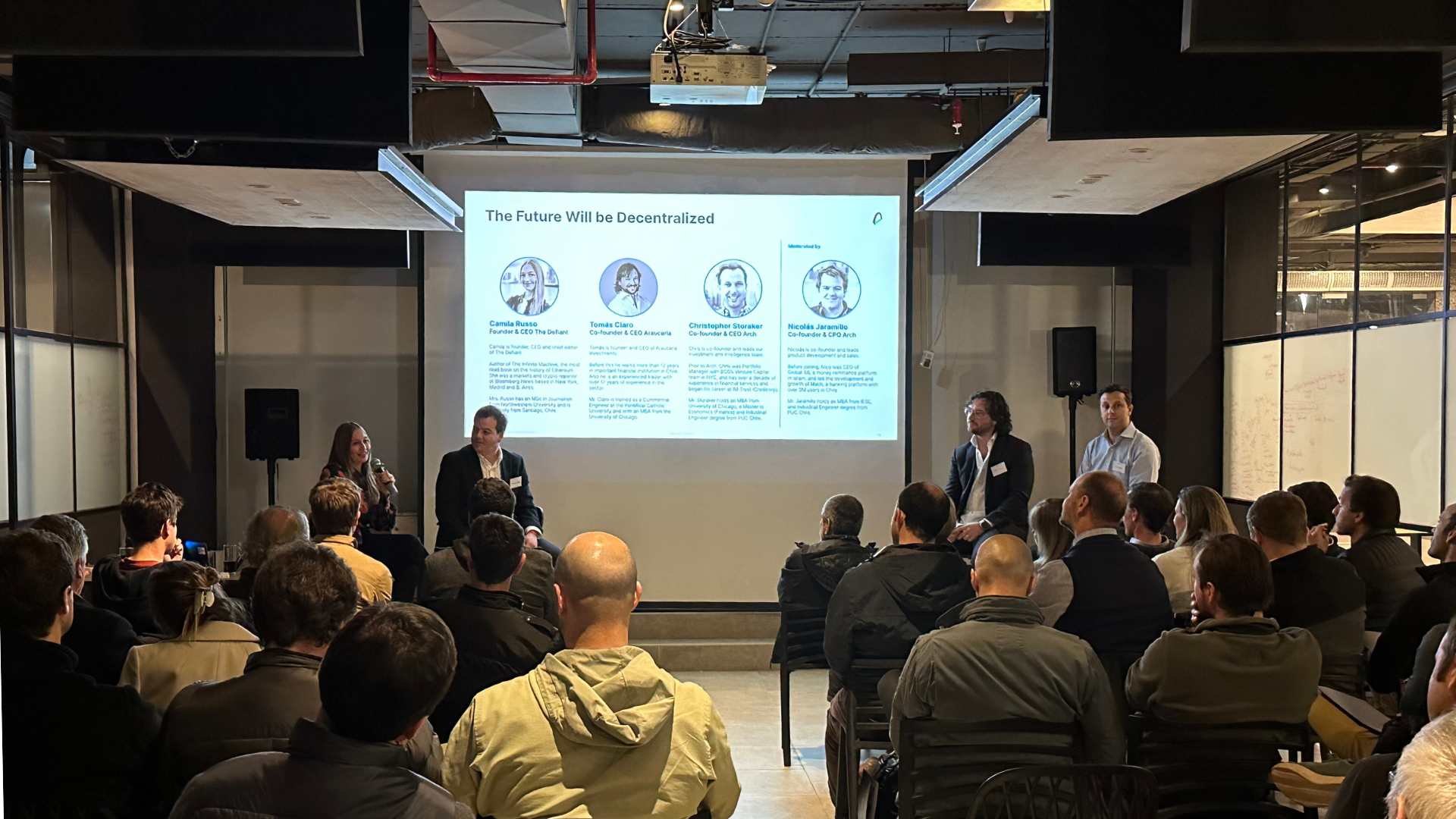Gm fellow Architects;
Q2 has been a sweet ride for the crypto market (and riskier assets in general). Picture this: prices are pumping and a major supply cut is coming up for one of the top assets.
Meanwhile, traditional businesses and finance are going all-in on crypto, left, right, and center. So get ready to be a connoisseur.
• Bitcoin performance is 5x higher than the S&P 500 in 2023.
• A halving season is coming up for Bitcoin (and could trigger the next bull run).
• Let's recap everything that has happened in crypto during Q2.
It's feeling like Bitcoin season: 5x higher than the S&P 500

2023 has been a fun rollercoaster for risky assets.
It's more than 2x the performance of the Nasdaq Composite (+31.7%) and 5x the S&P500 (+15.7%), the traditional benchmarks for equities and risk assets in general. That's not too shabby.
It is true that the great performance comes after a terrible 2022 when crypto was arguably the worst-performing asset class. Even after the strong performance in the year, Bitcoin is still 55% off its all-time value (~$68,800), reached on Nov/21.
However, mid and long-term investors - or diamond-hands holders as they are called in the space - are certainly not unpleased with a good compound annual rate of return.
Show me that compound annual rate of return
- 49.3%, for the past 3 years
- 36.8% for the past 5 years
And how that compares to other assets?
As a comparison, Nasdaq Index presented compounded returns of 8.6% (3 years) and 12.9% (5 years). So yes, that's a 4X for Bitcoin.
So is Bitcoin's long-term relationship material?
The short answer (that's not financial advice) is yes.
The long answer (that's still not financial advice) is that Bitcoin is a very volatile asset class - albeit experimenting with a reduction over time - but it has definitely paid off for those with a long-term mindset.
Blockchain analysis shows that 77% of all bitcoins are in profit (this value was 49% in December 2022, when it reached its recent bottom price), while the average price for each bitcoin in circulation purchased is roughly $20,330.
In plain English, please
This means that the average bitcoin holder sees a 50% return on their investment.
The numbers help to explain why “shrimps” (small-holders with less than 1 BTC) continue accumulating it. The number of wallets with over 1 BTC, just recently hit its highest number, surpassing 1 million addresses.
And people hold it or trade it?
Mostly hold it.
Another blockchain analysis shows that the percentage of bitcoins inactive for the past 12 months - i.e., not transacted or sold - rose to 70% versus 54% a year ago.
Cool. But what does it mean?
It shows that despite high volatility and sharp price movements, investors have understood the huge potential returns Bitcoin has delivered over the years. They keep accumulating coins, willing to hold them for longer, patiently waiting for the next bull run.
The next bull run could be around the corner with 2024’s halving

Bitcoin halving is when the reward for bitcoin mining is cut in half.
It means that the inflation rate of the protocol will pass from 1.8% to 0.83%, and the total number of BTC issued per year will reduce by 164,250. That number translates to a reduction of around $5bn USD/year in new supply of coins available for sale.
This amount is a huge drain on market liquidity
Since professional, industrial-scale companies mine most of bitcoins, a large part is immediately sold to pay for business expenses (electricity, overhead, loans, etc.).
The halve will represent a significant reduction of income for bitcoin miners, which ultimately reflects a lower supply of currencies available for sale in the market.
👉 If you're interested in knowing more on the topic, check out our deck about mining companies.
Let's take a trip down memory lane
As a historical recap, in the first halving (Nov/2012), bitcoin traded for only $12, and the halving removed $16mn of annual liquidity from the market.
In the second halving (Jul/2016), bitcoin traded for $651, and the halving removed $430mn of annual liquidity.
In the last halving (May/2020), bitcoin traded at $8,579, and the halving removed $2.8bn of annual liquidity.
The exponential appreciation in price combined to lower supply shows how demand for Bitcoin sky-rocketed over time.
The halving supply-shock dynamics have arguably sparked long periods of strong price appreciation.
The logic behind this pattern is:
- Following a halving, miners receive fewer bitcoins for each block mined, which reduces the selling pressure associated with covering miners' operating costs.
- Since prices are set at the margin, with a balance between supply and demand, this supply shock causes a BTC price increase.
- At the same time, the halving event generates buzz, drawing media attention and attracting new investors and speculators to the market.
- This pick-up in demand, associated with a decreased supply of new coins, creates a powerful combination that fuels BTC price appreciation.
How can I benefit from it?
You can gain exposure to Bitcoin through Arch Blockchains ($CHAIN), which encompass major existing blockchain protocols in a decentralized, transparent, and blockchain-verifiable way.
$CHAIN has performed 64.3% year to date.
It's time for a Q2 recap
Let's dive in and unravel the events that made Q2 one for the books.

⏱ If you only have time for the quick and dirty
- Large retailers and designers are having a love affair with crypto.
- TradFi is coming for crypto.
- The US sued some companies, decided to call securities a couple of tokens, and called some Bitcoin ETF proposals inadequate.
- The Shapella Upgrade was not the Great Unstaking.
☕️ If you want the full scoop
💙 On the love affair between every large company and crypto: It has been steamy. Dior is launching a new shoe called B33 with a corresponding NFT. Mastercard is launching a test version of its blockchain.
Adidas is killing it with their digital sneakers, and Ubisoft - the creators behind Assassins Creed - just announced a new Web3 game. Even Kellogg's is filing NFT trademarks for all their cereals.
🪙 On how interested TradFi is in crypto: Let's say they changed their minds—a lot.
BlackRock's CEO, Larry Fink, aka: the person running a multi-trillion dollar empire (~9T to be exact), went from saying "Bitcoin is an index for money laundering" in 2017 to claiming it's digital gold two days ago at an interview on Fox News. But that's not the only good thing he had to say about Bitcoin. He also said it's an alternative hedge against inflation or devaluation of fiat currencies.
And this is not only a BlackRock thing. Fidelity, Valkire, ARK, Invesco, WisdomTree, Citadel, Charles Schwab, and Deutsche Bank are all in a crypto frenzy, either filing for Bitcoin ETFs, seeking a license for crypto custody services, or launching new crypto market platforms.
🇺🇸 On what's going on with the US: We already covered the whole SEC suing Binance and Coinbase saga. They called Solana, Cardano, and Polygon securities during that suing spree. It has been no bueno for their prices.
On the other hand, many TradFi companies filed for Bitcoin ETFs. The SEC response? That proposals were inadequate, according to a The Wall Street Journal report.
It might seem bad. But it's not. It just means they needed to fix some things before resubmitting again. And Nasdaq (yes, THE Nasdaq) already refiled on behalf of BlackRock, ARK, and Valkyrie. Fidelity also refiled.
What is the major change in their applications? Surveillance-sharing agreements between Nasdaq/Chicago Mercantile Exchange & Coinbase. So now we just need to sit and wait until August to see if the first one gets approved.
⛓ On the Shapella Upgrade, the fears, and the boost: This is a crypto newsletter, and we spent a good chunk of time talking about banks, cereal companies, and the stock market. So it's time to get back to crypto. Enter The Shapella Upgrade.
The Shapella Upgrade was probably one of the most hyped-up tech upgrades in Ethereum. The reason? It allowed users to unstake their tokens for the first time.
Everyone thought this would create a max exodus, with users unstaking all their holdings the second it went live. But quite the opposite. The deployment was smooth sailing. So smooth that ETH rallied after. And now there's more ETH staked than there is ETH on exchanges.
Interest in staking and liquid staking solutions is also increasing, which is good for the safety and health of the network.
🗞 In other news - Powered by The Defiant
- Web3 Apps gained users in June despite regulatory challenges
- Ethereum developers propose circuit breakers to deter hackers
- Crypto gains more than double than traditional assets in first half 0f 2023
🎤 You can call us hosts
We hosted an event with asset managers and investors to talk about the role of crypto in traditional portfolios.

Camila Russo, Founder of The Defiant, and Tomas Claro, Araucaria CEO, accompanied us.
If you also want to know how crypto could fit into your portfolio, schedule a meeting with Nicolas Jaramillo, our Co-Founder, who can answer any questions you may have.
Book a time that works for you using our scheduling link.
📺 Look mom, we’re on the news!
Sharing why diversification pays off when investing in Web3

Disclaimer: The opinions expressed are for general informational purposes only and are not intended to provide specific advice or recommendations. The views reflected in the commentary are subject to change without notice


